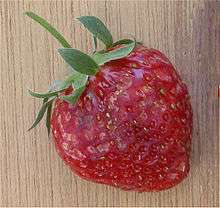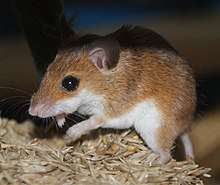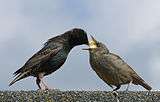Seed predation
Seed predation, often referred to as granivory, is a type of plant-animal interaction in which granivores (seed predators) feed on the seeds of plants as a main or exclusive food source,[1] in many cases leaving the seeds damaged and not viable. Granivores are found across many families of vertebrates (especially mammals and birds) as well as invertebrates (mainly insects);[2] thus, seed predation occurs in virtually all terrestrial ecosystems. Seed predation is commonly divided into two distinctive temporal categories, pre-dispersal and post-dispersal predation, which affect the fitness of the parental plant and the dispersed offspring (the seed), respectively. Mitigating pre- and post-dispersal predation may involve different strategies. To counter seed predation, plants have evolved both physical defenses (e.g. shape and toughness of the seed coat) and chemical defenses (secondary compounds such as tannins and alkaloids). However, as plants have evolved seed defenses, seed predators have adapted to plant defenses (e.g., ability to detoxify chemical compounds). Thus, many interesting examples of coevolution arise from this dynamic relationship.
| Look up granivore in Wiktionary, the free dictionary. |

Seeds and their defenses

Plant seeds are important sources of nutrition for animals across most ecosystems. Seeds contain food storage organs (e.g., endosperm) that provide nutrients to the developing plant embryo (cotyledon). This makes seeds an attractive food source for animals because they are a highly concentrated and localized nutrient source in relation to other plant parts.
Seeds of many plants have evolved a variety of defenses to deter predation. Seeds are often contained inside protective structures or fruit pulp that encapsulate seeds until they are ripe. Other physical defenses include spines, hairs, fibrous seed coats and hard endosperm. Seeds, especially in arid areas, may have a mucilaginous seed coat that can glue soil to seed hiding it from granivores.[3]
Some seeds have evolved strong anti-herbivore chemical compounds. In contrast to physical defenses, chemical seed defenses deter consumption using chemicals that are toxic or distasteful to granivores or that inhibit the digestibility of the seed. These chemicals include toxic non-protein amino acids, cyanogenic glycosides, protease and amylase inhibitors, and phytohemaglutinins.[1] Plants may face trade-offs between allocation toward defenses and the size and number of seeds produced.
Plants may reduce the severity of seed predation by making seeds spatially or temporally scarce to granivores. Seed dispersal away from the parent plant is hypothesized to reduce the severity of seed predation.[4][5] Seed masting is an example of how plant populations are able to temporally regulate the severity of seed predation. Masting refers to a concerted abundance of seed production followed by a period of paucity. This strategy has the potential to regulate the size of the population of seed predators.
Seed predation vs. seed dispersal
Adaptations to defend seeds against predation can impact seeds' ability to germinate and disperse. Thus anti-predator adaptations often occur in a suite of adaptations for a particular seed life history. For example, chili plants selectively deter mammal seed predators and fungi using capsaicin, which does not deter bird seed dispersers[6][7] because bird taste receptors do not bind with capsaicin. Chili seeds in turn have higher survival if they pass through a bird's stomach than if they fall to the ground.[8]
Pre- and post-dispersal
Seed predation can occur both before and after seed dispersal.[9]
Pre-dispersal
Pre-dispersal seed predation takes place when seeds are removed from the parent plant before dispersal, and it has been most often reported in invertebrates, birds, and in granivorous rodents that clip fruits directly from trees and herbaceous plants. Post-dispersal seed predation arises once seeds have been released from the parent plant. Birds, rodents, and ants are known to be among the most pervasive postdispersal seed predators. Furthermore, postdispersal seed predation can take place at two contrasting stages: predation on the "seed rain" and predation on the "seed bank". Whereas predation on the seed rain occurs when animals prey on released seeds usually flush with the ground surface, predation on the seed bank takes place after seeds have been incorporated deeply into the soil.[1] Nevertheless, there are important vertebrate pre-dispersal predators, especially birds and small mammals.
Post-dispersal
Post-dispersal seed predation is extremely common in virtually all ecosystems. Given the heterogeneity in both resource type (seeds from different species), quality (seeds of different ages and/or different status of integrity or decomposition) and location (seeds are scattered and hidden in the environment), most post-dispersal predators have generalist habits.[1] These predators belong to a diverse array of animals, such as ants, beetles, crabs, fish, rodents and birds. The assemblage of post-dispersal seed predators varies considerably among ecosystems.[1] A dispersed seed is the first independent life stage of a plant, thus post-dispersal seed predation is the first potential mortality event and one of the first biotic interactions in a plant's life cycle.
Differences
Both pre- and post-dispersal seed predation are common. Pre-dispersal predators differ from post-dispersal predators in most often being specialists, adapted to clustered resources (on the plant). They use specific cues like plant chemistry (volatile compounds), color, and size to locate seeds, and their short life cycles often match the production of seeds by the host plant. Insect groups containing many pre-dispersal seed predators are Coleoptera, Hemiptera, Hymenoptera and Lepidoptera.[1]
Effects on plant demography
The complex relationship between seed predation and plant demography is an important topic of plant-animal interactive studies. Plant population structure and size over time is closely associated with the effectiveness at which seed predators locate, consume, and disperse seeds. In many cases this relationship depends on the type of seed predator (specialist vs. generalist) or the particular habitat in which the interaction is taking place. The role of seed predation on plant demography may be either detrimental or in particular cases actually beneficial to plant populations.
The Janzen-Connell model concerns how seed density and survival respond to distance from the parent tree and differential rates of seed predation. Seed density is hypothesized to decrease as distance from the parent tree increases. Where seeds are most abundant under the parent tree, seed predation is predicted to be at its highest. As distance from the parent tree increases, seed abundance and thus seed predation are predicted to decrease as seed survival increases.[4][5]
The degree to which seed predation influences plant populations may vary by whether a plant species is safe site limited or seed limited. If a population is safe site limited it is likely that seed predation will have little impact to the success of the population. In safe site limited populations increased seed abundance does not translate into increased seedling recruitment. However, if a population is seed limited, seed predation has a better chance of negatively affecting the plant population by decreasing seedling recruitment. Maron and Simms[10] found both safe site limited and seed limited populations depending on the habitat in which the seed predation was taking place. In dune habitats seed predators (deer mice) were limiting seedling recruitment in the population, thus negatively affecting the population. However, in grassland habitat the seed predator had little effect on the plant population because it was safe site limited.
In many cases seed predators support plant populations by dispersing seeds away from the parent plant, in effect supporting gene flow between populations. Other seed predators collect seeds and then store or cache them for later consumption.[11] In the case that the seed predator is unable to locate the buried or hidden seed there is a chance that it will later germinate and grow, supporting the species dispersal. Generalist (vertebrate) seed predators may also aid the plant in other indirect ways, for instance by inducing top-down control on host-specific seed predators (termed "intra-guild predation"), and as such negating Janzen-Connell type effects and so benefiting the plant in competition with other plant species.[12]
See also
- Consumer-resource systems
- Egg predation
- Harvester ant
- Herbivory
- Seed dispersal
References
- Hulme, P.E. and Benkman, C.W. (2002) "Granivory", pp. 132–154 in Plant animal Interactions: An Evolutionary Approach, ed. C.M. Herrera and O. Pellmyr. Oxford: Blackwell. ISBN 978-0-632-05267-7.
- Janzen, D H (1971). "Seed Predation by Animals". Annual Review of Ecology and Systematics. 2: 465–492. doi:10.1146/annurev.es.02.110171.002341.
- Tiansawat, Pimonrat; Davis, Adam S.; Berhow, Mark A.; Zalamea, Paul-Camilo; Dalling, James W. (2014-06-13). Chen, Jin (ed.). "Investment in Seed Physical Defence Is Associated with Species' Light Requirement for Regeneration and Seed Persistence: Evidence from Macaranga Species in Borneo". PLoS ONE. 9 (6): e99691. Bibcode:2014PLoSO...999691T. doi:10.1371/journal.pone.0099691. ISSN 1932-6203. PMC 4057182. PMID 24927025.
- Janzen, D. H. (1970). "Herbivores and the number of tree species in tropical foresets" (PDF). The American Naturalist. 104 (940): 592–595. doi:10.1086/282687.
- Connell, J.H. (1971) "On the role of natural enemies in preventing competitive excusion in some marine animals and in rainforest trees", pp. 298–312 in Dynamics of Populations, ed. P.J. den Boer and G.R. Gradwell. Wageningen: Center for Agricultural Publishing and Documentation.
- Gary P. Nabhan; Tewksbury, Joshua J. (July 2001). "Seed dispersal: Directed deterrence by capsaicin in chillies". Nature. 412 (6845): 403–404. doi:10.1038/35086653. ISSN 1476-4687. PMID 11473305.
- Correspondent, David Derbyshire, Science (2001-07-25). "Why birds find chilli peppers so cool". Daily Telegraph. ISSN 0307-1235. Retrieved 2019-03-14.
- "Bird Gut Boosts Wild Chili Seed Survival". Inside Science. 2013-07-15. Retrieved 2019-03-14.
- Fedriani, J. M.; Manzoneda, A. (2005). "Pre- and post-dispersal seed predation by rodents: balance of food and safety". Behavioral Ecology. 16 (6): 1018. doi:10.1093/beheco/ari082.
- Maron, John L.; Simms, Ellen L. (1997). "Effect of seed predation on seed bank size and seedling recruitment of bush lupine (Lupinus arboreus)". Oecologia. 111 (1): 76–83. Bibcode:1997Oecol.111...76M. doi:10.1007/s004420050210. PMID 28307508.
- Harper, J. L. (1977) Population Biology of Plants, New York: Academic Press.
- Visser, Marco D.; Muller-Landau, Helene C.; Wright, S. Joseph; Rutten, Gemma; Jansen, Patrick A. (2011). "Tri-trophic interactions affect density dependence of seed fate in a tropical forest palm". Ecology Letters. 14 (11): 1093–1100. doi:10.1111/j.1461-0248.2011.01677.x. ISSN 1461-023X. PMID 21899693.
Further reading
- Alexander, H.M.; Cummings, C.L.; Kahn, L.; Snow, A.A. (2001). "Seed size variation and predation of seeds produced by wild and crop–wild sunflowers". American Journal of Botany. 88 (4): 623–627. doi:10.2307/2657061. JSTOR 2657061.
- Andersen, A.N. (1989). "How Important Is Seed Predation to Recruitment in Stable Populations of Long-Lived Perennials?". Oecologia. 81 (3): 310–315. Bibcode:1989Oecol..81..310A. doi:10.1007/bf00377076. PMID 28311181.
- Berenbaum, M.R; Zangerl, AR. (1998). "Chemical phenotype matching between a plant and its insect herbivore". Proceedings of the National Academy of Sciences. 95 (23): 13743–13784. Bibcode:1998PNAS...9513743B. doi:10.1073/pnas.95.23.13743.
- Brown, J.H.; Heske, E.J. (1990). "Control of a desert-grassland transition by a keystone rodent guild". Science. 250 (4988): 1705–1707. Bibcode:1990Sci...250.1705B. doi:10.1126/science.250.4988.1705. PMID 17734708.
- Brown, J.H.; Reichman, O.J.; Davidson, D.W. (1979). "Granivory in desert ecosystems". Annual Review of Ecology and Systematics. 10: 201–227. doi:10.1146/annurev.es.10.110179.001221.
- Davidson, D.W. (1993). "The Effects of Herbivory and Granivory on Terrestrial Plant Succession". Oikos. 68 (1): 23–35. doi:10.2307/3545305. JSTOR 3545305.
- Davidson, D.W.; Brown, J.H.; Inouye, R.S. (1980). "Competition and the Structure of Granivore Communities". BioScience. 30 (4): 233–238. doi:10.2307/1307877. JSTOR 1307877.
- Diaz, M.; Telleria, J.L. (1996). "Granivorous Birds in a Stable and Isolated Open Habitat within the Amazonian Rainforest". Journal of Tropical Ecology. 12 (3): 419–425. doi:10.1017/s0266467400009615.
- Figueroa, J.A.; Muñoz, A.A.; Mella, J.E.; Arroyo, M.T. K. (2002). "Pre- and post-dispersal seed predation in a Mediterranean-type climate montane sclerophyllous forest in central Chile". Australian Journal of Botany. 50 (2): 183–195. doi:10.1071/bt01003.
- Lundgren, J; Rosentrater, K (2007). "The strength of seeds and their destruction by granivorous insects". Arthropod-Plant Interactions. 1 (2): 93–99. doi:10.1007/s11829-007-9008-1.
- Mares, M.A.; Rosenzweig, M.L. (1978). "Granivory in North and South American Deserts: Rodents, Birds, and Ants". Ecology. 59 (2): 235–241. doi:10.2307/1936368. JSTOR 1936368.
- Oliveras, J.; Gomez, C.; Bas, M.; Espadaler, X. (2008). "Mechanical Defence in Seeds to Avoid Predation by a Granivorous Ant". Naturwissenschaften. 95 (6): 501. Bibcode:2008NW.....95..501O. doi:10.1007/s00114-008-0349-0. PMID 18288470.
- Sallabanks, R.; Courtney, S.P. (1992). "Frugivory, Seed Predation and Insect- Vertebrate Interactions". Annual Review of Entomology. 37: 337–400. doi:10.1146/annurev.en.37.010192.002113. PMID 1539939.
- Smith, CC (1970). "The coevolution of pine squirrels (Tamiasciurus) and conifers". Ecological Monographs. 40 (3): 349–371. doi:10.2307/1942287. JSTOR 1942287.
- Vander Wall, S.B.; Kuhn, K.M.; Beck, M.J. (2005). "Seed Removal, Seed Predation, and Secondary Dispersal". Ecology. 86 (3): 801–806. doi:10.1890/04-0847.
